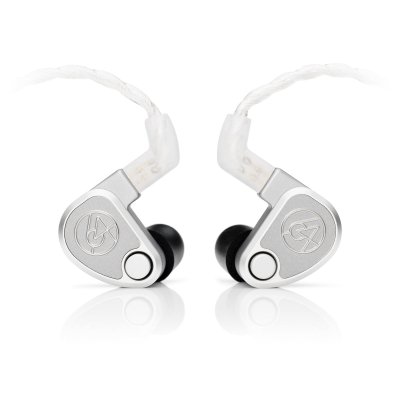64 Audio U12T and Aful Cantor use 12BA and 14BA driver setups respectively. 64 Audio U12T costs $1,999 while Aful Cantor costs $800. 64 Audio U12T is $1,199 more expensive. 64 Audio U12T holds a clear 0.6-point edge in reviewer scores (8.3 vs 7.6). User ratings place 64 Audio U12T at 8.2 and Aful Cantor at 8.5. 64 Audio U12T has significantly better bass with a 1.5-point edge, 64 Audio U12T has significantly better mids with a 1.2-point edge, Aful Cantor has better treble with a 0.7-point edge, 64 Audio U12T has significantly better dynamics with a 1.7-point edge, 64 Audio U12T has slightly better details with a 0.3-point edge and 64 Audio U12T has better imaging with a 0.6-point edge.
Insights
| Metric | 64 Audio U12T | Aful Cantor |
|---|---|---|
| Bass | 8.5 | 7 |
| Mids | 8.2 | 7 |
| Treble | 7.7 | 8.4 |
| Details | 8.9 | 8.6 |
| Soundstage | 8.2 | 8 |
| Imaging | 9.1 | 8.5 |
| Dynamics | 7.7 | 6 |
| Tonality | 8.1 | 7.8 |
| Technicalities | 8.7 | 9 |
64 Audio U12T Aggregated Review Score
Average Reviewer Scores
Average Reviewer Score:
8.3Very Positive
Aful Cantor Aggregated Review Score
Average Reviewer Scores
Average Reviewer Score:
7.6Strongly Favorable
Reviews Comparison
64 Audio U12T reviewed by Super* Review
Youtube Video Summary
The 64 Audio U12t lands exactly where its reputation suggests: a warm, laid-back, yet highly detailed all-rounder that stays engaging without ever turning fatiguing. With the apex M15 module, bass shifts toward a tasteful sub-bass lift that adds punch and body while keeping the midrange clean; vocals sit a touch relaxed, and the treble reaches high with smooth extension and air. Despite being an all-BA set, the low end carries surprising weight and macro-dynamics, and the overall presentation feels effortless and cohesive—“does-it-all” tuning done right.
Trade-offs are minor: timbre can sound slightly artificial at times, and dropping to the M10 module trims bass but also some excitement. Build is comfortable and compact, though the stock cable is annoyingly wiry and memory-prone. Against its stablemates, U12t stands as the benchmark: cleaner and less fatiguing than U18t, more versatile than the warmer Nio (with M15), and less head-stage wow than Trio but more universally balanced. End result: a confident 5/5 for a high-price IEM that actually feels worth chasing if this signature hits the brief.
Super* Review original ranking
Super* Review Youtube ChannelBuy 64 Audio U12T on audio46
Ad
Price: $1,999
Buy 64 Audio U12T on audio46
Aful Cantor reviewed by Super* Review
Youtube Video Summary
The AFUL Cantor lands as a flagship all-BA set with 14 balanced armatures at $800, packaged with a great-handling nylon cable and a handsome shell. The catch is fit: a very long nozzle with a metal insert demands a deep insertion, and comfort varies widely; AFUL’s stock tips are essentially required to keep that nozzle from poking and to restore some flex. Build and presentation impress, but the ear-fit can be fussy and the shells tend to stick out.
Tuning trends U-shaped: a lower-mid dip into a hefty sub-bass boost, relaxed upper mids, and noticeable upper-treble energy. When seated correctly, the set delivers crisp transients with a touch of “planar-like” pluck, good imaging, and clean BA bass that favors electronic thump over kick-drum slam; with the wrong tip or depth it swings to brittle/bright or muted. The midrange can read a bit thin, so the contrast comes more from bass/treble edges than from vocal saturation.
Compared with Symphonium Helios, both are all-BA and graph-adjacent, but Helios leans vocal-forward and smooth while Cantor is the more contrasty, fun listen that trades mid presence for excitement. Net: technically capable and competitive when dialed in, yet compromised by comfort and tip dependence. Final verdict: 3/5 stars—a better match for listeners with deep pockets and deep ears.
Super* Review original ranking
Super* Review Youtube ChannelBuy Aful Cantor on HiFiGO
Ad
Price: $687
Buy Aful Cantor on HiFiGO
64 Audio U12T reviewed by Audionotions
Aful Cantor reviewed by Audionotions
64 Audio U12T reviewed by Jays Audio
Youtube Video Summary
Presented as a former favorite turned cautionary tale, the 64 Audio U12t shows a neutral-warm bass with good texture, speed, and separation, though the mid-bass can feel unnecessary for a non–bass-head tuning. Trouble starts at the 3 kHz scoop, where vocals lose presence and clarity; attempts to restore bite via added treble create sharpness instead of openness, with emphasized peaks around 13 kHz and 17 kHz. This combo makes volume scaling tricky—either accept recessed vocals or endure fatiguing highs—though the treble is otherwise solid from 6–10 kHz. Technical chops are undeniably strong: detail retrieval, instrument layering, and imaging are top-tier, with quick attacks and clean separation across the stage. Still, the staging feels wide yet flat, as the recessed mids reduce depth and contrast, and dynamic tracks (K-pop/J-pop/J-rock) expose the unevenness, prompting constant volume tweaks; slower, softer material fares better. Given the vocal recession and treble fatigue, the value proposition is questioned for a $2,000 set—alternatives like the Variations and EGL7m offer more open, extended vocals with smoother treble, while RS5 and Heyday provide extra warmth without the same pitfalls.
Jays Audio Youtube Channel
Aful Cantor reviewed by Jays Audio
Youtube Video Summary
The Aful Cantor presents a complex and frustrating case, offering what might be some of the most detailed and resolving performance under $1,000. The clarity, separation, and sheer resolution are described as "pretty nuts," positioning the Cantor as a potential benchmark for technical ability. It delivers a clean, smooth, light, and airy sound signature with a bass that is very fast, lean, and features a tight sub-bass rumble. At lower volumes, this presentation is highly enjoyable and non-fatiguing, making it exceptionally good for critical, quiet listening sessions where its technical prowess can shine without drawback.
However, this technical marvel comes with a significant and unusual caveat: it is physically fatiguing to the point of causing headaches and a ringing sensation in the temples after only 15-30 minutes of listening at moderate volumes (around 70-80 dB). This is not a fit or nozzle issue, but rather an inherent property of the IEM itself. The problem manifests as a shrill and overly intense quality in the treble at higher volumes, accompanied by a metallic timbre on tracks with lots of cymbals, making it unsuitable for energetic genres like K-pop, J-pop, or EDM. This shrillness is not fully solved by EQ and is believed to be related to the driver design, nozzle, or venting rather than just the tuning.
When compared to peers, the Cantor is more resolving than the warmer, fuller, and smoother Letshuoer Supernova but falls short of its natural timbre. It also can't match the Monarch MK3 as an all-rounder, which offers a more impactful bass, better vocals, and a smoother, more engaging experience. The Cantor's vocals are also a weak point, being recessed, light, and borderline thin. The final recommendation is to definitely demo these first; they are only easy to recommend for those who listen at very low volumes (under 60 dB) and are not sensitive to treble intensity, as its scaling at normal listening levels is poor.
Jays Audio Youtube Channel
64 Audio U12T reviewed by Shuwa-T
Aful Cantor reviewed by Shuwa-T
64 Audio U12T reviewed by Kois Archive
Kois Archive Youtube Channel
Aful Cantor reviewed by Kois Archive
Youtube Video Summary
AFUL Cantor is a 14-BA, ~$800 set that looks premium and shows off its acoustic maze tubing through a semi-transparent shell, with faceplates in Star Knight or Marine Echo. The fit can be tricky: a long metal nozzle wants a deep insertion, and short tips won’t seal; longer tips like SoftEars Ultra Clear or Dunu S&S keep the nozzle covered and the tonality stable. The stock nylon cable feels nice but is very microphonic, making a swap advisable. Measurement quirks from shallow insertion are misleading—proper deep fit removes the apparent treble spike and reflects what’s actually heard.
Tuning follows the AFUL house sound: a mild U-shape, fairly neutral with a brightish tilt. The maze tech gives BA bass surprising decay and texture, with neutral mid-bass and a touch more sub-bass focus—close to a DD feel, if not identical. Mids sit clean; female vocals sound natural and sweetened by the steady rise through the upper-mids, while a gentle ~300 Hz dip makes male vocals and lower-octave instruments a bit lean. Treble is smooth yet energetic, with standout extension (impressively achieved without ESTs); it hovers near the upper tolerance for brightness but remains controlled with the right tips.
Technical performance is where Cantor shines: top-tier resolution, precise imaging, and a notably wide soundstage—great for detail retrieval and gaming, where positional cues pop (think footstep clarity in FPS titles). Versus Performer 7, Cantor trades P7’s fuller low-mids and better male vocals for cleaner female vocals and a more even treble. Against 64 Audio U12t, Cantor’s bass quality impresses, its mids differ (U12t’s 3 kHz dip adds sweetness but can feel odd), and Cantor’s treble sounds smoother; both resolve at a very high level, with Cantor edging imaging and stage width. Overall: an excellent but not universal pick—cable microphonics, deep-fit demands, and slightly thin lower mids mean careful matching to preferences. For detail lovers with female-vocal libraries who tolerate a brighter treble, it earns a one-star recommendation; others may prefer alternatives in this bracket.
Kois Archive Youtube Channel
64 Audio U12T reviewed by Jaytiss
Jaytiss Youtube Channel
Aful Cantor reviewed by Jaytiss
Youtube Video Summary
The AFUL Cantor delivers a balanced and neutral sound signature, praised for its exceptional upper air, treble extension, and pristine clarity. While the bass offers sufficient dynamics without being thunderous, and female vocals sound natural, some listeners might desire a touch more punch in the upper mids (around 2-3kHz) and find a slight peak in the 4-6kHz region occasionally noticeable. The premium build quality stands out, featuring a unique and stunning "star night" face plate, a thick but comfortable shell with a slender nozzle, and excellent accessories. These include a slightly microphonic but otherwise nice-looking flat two-pin cable and an exceptionally plush case typically found on far more expensive IEMs.
Graph comparisons reveal the Cantor's tuning shares similarities with models like the Moondrop Blessing 2: Dusk and the AFUL Explorer, but it distinguishes itself with superior detail retrieval and dynamics. It competes impressively against significantly pricier offerings like the Elysian Annihilator in technical performance, offering a smoother presentation with slightly less sub-bass focus. The overall sonic presentation is described as sophisticated, refined, and highly engaging, creating a sense of music surrounding the listener. Minor tuning preferences aside – wishing for a bit more upper mid presence and slightly less energy around 4-6kHz and 8kHz – the core sound quality is highly regarded.
Representing strong sonic value despite its price point, the Cantor earns a high ranking for its unique and beautiful design, premium feel, and exceptional technical performance. While acknowledging excellent cheaper options like the AFUL Explorer exist, the Cantor justifies its cost with its detailed, airy presentation and overall package. It's highly recommended for those seeking a neutral, high-performing IEM, though a demo is advised given the investment. Ultimately, the AFUL Cantor is considered a treasure, fulfilling over a year of anticipation with its beautiful aesthetics and uniquely engaging sound.
Jaytiss Youtube Channel
64 Audio U12T reviewed by Head-Fi.org
Aful Cantor reviewed by Head-Fi.org
64 Audio U12T (more reviews)
64 Audio U12T reviewed by Nymz
64 Audio U12T reviewed by Precogvision
Youtube Video Summary
Presentation falls short of flagship expectations—especially the stock cable, which feels flimsy and uninspiring—but the tuning is where the 64 Audio U12t earns its reputation. With a gently U-shaped response and swappable apex modules altering bass quantity (M10 leaner; M15/M20 adding a deeper, sub-bass-tilted shelf), the low end carries uncommon texture and decay for an all-BA setup while preserving BA speed and control. The sub-bass shelf levels off around 200Hz, avoiding midrange bleed and keeping the overall tonality clean and balanced.
The mids are slightly scooped yet inoffensive, with ear-gain centering near 2kHz and a tasteful dip through 2–5kHz that preserves depth without hollowing out vocals. Treble is distinctive thanks to the tia super tweeter mounted at the nozzle: a mid-treble dip followed by pronounced peaks around 15–17kHz creates a sense of airy “pseudo-treble” that some listeners (especially younger ears) perceive as bright, while others may find it dark if those upper harmonics aren’t audible. Tip choice matters—Spinfits can emphasize air, while Final E can tame the top end—making the signature unusually tunable to preference.
On the technical front, the U12t is highly resolving, pulling micro-details forward with ease, yet its transient attack has a subtle softness that gives an “analog” character rather than razor-edged sharpness. Where it truly distinguishes itself is macrodynamics—quiet-to-loud swings feel visceral and engaging, a rarity among BA designs and rivaled only by a select few dynamic-driver flagships. Summed up, it’s the “90-in-every-subject” kind of performer: maybe not the single best at any one metric, but making the fewest compromises across the board. For anyone seeking a well-rounded flagship that handles almost anything with poise, the U12t remains a top recommendation.
Precogvision Youtube Channel
64 Audio U12T reviewed by Yifang
Youtube Video Summary
Unique Melody MEST MKII brings a distinctive recipe: a DD + 4BA + 2EST array augmented by a full-range bone-conduction driver, translating to a relaxed yet vividly holographic presentation. Bass quantity sits in the pocket—neither shy nor boomy—while the sub-bass extension digs deep and rumbles on cue, sketching out stage width and depth with authority. Mid-bass hits cleanly but avoids brute-force slam, keeping space clear for detail. Mids read a touch lean/diffused: tonally correct and easygoing, gorgeous on plucked strings, a bit light in note weight for violins and cellos. Treble is sparkly without sibilance at sane volumes; push volume for bigger bass hits and the upper range can tip into fatigue. Don’t over-trust FR graphs here—the BC driver adds presence that won’t show on measurements.
Technical chops are firmly high-end: resolution and separation impress, EST speed makes cymbals and chimes glide, and dynamics pop when sub-bass swells. The staging is the showstopper—layered, airy, and convincingly 3D (hell yeah). Versus peers, MEST MKII trades some midrange weight/tonality for superior sparkle and more satisfying bass texture; sets like V16 Divinity or Elysian Diva may win for mids, but MEST counters with atmosphere and bite up top. With the current price drop around the ~$1k mark, it becomes an easy recommendation for those seeking immersive imaging and sub-bass architecture—just ditch the atrocious stock cable ergonomics and enjoy the ride.
Yifang Youtube Channel
64 Audio U12T reviewed by Smirk Audio
64 Audio U12T reviewed by Tim Tuned
Tim Tuned Youtube Channel
64 Audio U12T reviewed by Crin
64 Audio U12T reviewed by Web Search
The 64 Audio U12t is a mature flagship-class UIEM built around twelve balanced armatures per side and the company’s tia (open-BA) and apex pressure-relief tech; it lists at $1,999. Module options (mX/m15/m20) vary isolation from roughly −10 to −20 dB, giving modest control over perceived balance without changing the core tuning. The driver split—1 tia high, 1 high-mid, 6 mid, 4 low—aims for coherence via a 4-way crossover in a compact, aluminum shell.
Tonally the U12t trends neutral with a sub-bass lift, yielding clean mids and controlled, generally safe treble; frequency-response databases show the gentle low-end emphasis with even mids. Swapping apex modules can nudge the balance (e.g., M20 a bit more bass, M15 a touch airier) without altering the U12t’s fundamental character. Technical performance remains the calling card: resolution, imaging, layering, and BA-bass quality are repeatedly praised at the top of the class.
Trade-offs are mostly about preference and price: treble can read polite with minor quirks depending on chain and tips, and midrange body is slightly lean versus warmer sets. Given the premium MSRP, overall value hinges on prioritizing top-tier technicalities and long-session comfort via apex.
Aful Cantor (more reviews)
Aful Cantor reviewed by Z-Reviews
Youtube Video Summary
This is AFUL’s flagship science project: the Cantor packs 14 BAs per side (28 total) and a heap of buzzword tech—Dual-Channel Acoustic Maze for sub-bass, non-destructive direct-drive topology, and multi-dimensional crossover trickery that reads like Star Trek schematics. The housing even extends a stainless-steel nozzle to the tip’s end to bypass tip coloration—smart for consistency, dicey for ears with wide-bore silicones. Stick to the stock silicones or better yet foams to calm treble and avoid any scrape-risk.
Sonically it’s a hyper-resolving analyzer: every band is so present that volume tends to go down, not up, and mediocre recordings get roasted on the spot. Imaging is precise but a bit less cohesive than simpler sets; stage stays as the track dictates, while separation feels like a mixing desk with 14 faders. The sub-bass dives shockingly deep for an all-BA—think whisper-low “whoomp”—yet it isn’t a bass-monster; overall balance leans revealing rather than lush.
Pairing matters: clinical amps make it razor-edged, while warmer sources (R2R, iFi, RME-ish) and foam tips smooth it into addictive detail. At $800 it isn’t the one IEM to rule them all; it’s the specialist tool for listeners who want to dissect space, mic technique, and mix decisions—more control room than mosh pit. Cable and case are solid (4.4 mm balanced), and a tuning switch would have been nice, but for the right kind of nerd this thing lets you become the squig.
Z-Reviews Youtube Channel
Aful Cantor reviewed by Gizaudio Axel
Gizaudio Axel original ranking
Gizaudio Axel Youtube ChannelAful Cantor reviewed by Paul Wasabii
Youtube Video Summary
AFUL Cantor presents as a premium 14 balanced armature set with solid build quality and a distinctive elongated nozzle, but that nozzle makes fit unusually finicky for an 800 dollar IEM. Finding the midpoint between shallow and deep insertion is critical, as too shallow makes the treble peaky while too deep collapses the stage and dulls extension. The whole experience of tip selection and insertion feels overly complicated at this price, with questionable payoff for the effort.
The tuning follows a very U shaped profile where sub bass and upper treble act as the tent poles and the entire midrange sits relatively flat and lean. Bass is tight and textured but heavily sub bass focused, with very little mid bass weight, leading to a clean yet somewhat sterile presentation that leaves lower mids thin and lacking body. Mids themselves are clean and reasonably natural thanks to a restrained ear gain region, but the combination of reduced mid bass and elevated upper treble pushes the overall balance toward a cool, unengaging character rather than a rich, everyday listen.
Where Cantor excels is in technical performance: resolution, micro detail and treble clarity are strong, and the BA timbre is impressively well controlled, giving the set a crisp, analytical edge. However, the reliance on upper treble energy to restore presence can become fatiguing on bright material, and the otherwise good stage is highly dependent on nailing the exact fit, making the presentation inconsistent from listener to listener. Taken together, Cantor feels more like a high priced specialist tool for those who prioritize technicalities over warmth and musicality than a balanced, broadly appealing flagship all rounder.
Paul Wasabii Youtube Channel
Aful Cantor reviewed by Audio Amigo
Youtube Video Summary
AFUL’s $800 flagship pushes hard on engineering: 14 balanced armatures, a five-way network, 3D-printed shells, and the brand’s acoustic maze that coaxes unusually textured, dynamic-driver-like bass out of an all-BA setup. Packaging is “classic AFUL”—nice case, multiple tip sets, cleaning brush—but light for the price, and the cloth-sheathed cable, while beautifully machined and very low resistance, is highly microphonic. The big talking point is the metal nozzle extension: tips must be pushed down to the rim for a deep fit, which optimizes tonality and treble smoothness. Comfort varies wildly by ear; some report irritation, and the long nozzle feels fragile if dropped.
Sonically, this is AFUL’s house sound elevated: a slightly warm-neutral balance with clean, meaty lows, natural mids, and an upper-mid/treble that sits right on the edge—silky and detailed with a deep fit, but bright and fatiguing if worn shallow or with the wrong tips. It is extremely revealing of mastering quality, rewarding good recordings with elite microdetail, imaging, and a huge, tall stage that can hang with far pricier sets. A mild impedance adapter (or higher-Z source) can warm the tone and shave some air, though at a small cost to sparkle and openness.
Against AFUL’s own lineup, the closest kin is the Performer 7: similar flavor, less resolution and scale, but a far better value. Cantor is the brand’s “thesis statement”—the most complete execution of its tuning—with true summit-fi technicals at a mid-summit price. Still, it carries caveats: fit sensitivity, that microphonic cable, and accessory stinginess. Recommended only if the budget is comfortable, a deep, stable fit is achievable and comfortable for long sessions, and AFUL’s warm-neutral house sound already hits the spot; for everyone else, the P7 or Explorer make safer picks.
Audio Amigo Youtube Channel
64 Audio U12T Details
Driver Configuration: 12BA
Tuning Type: Neutral with Bass Boost
Brand: 64 Audio Top 64 Audio IEMs
Price (Msrp): $1,999
Support our free service! Buying through our affiliate links costs you nothing extra:
Aful Cantor Details
Driver Configuration: 14BA
Tuning Type: Vocal-focused
Brand: AFUL Top AFUL IEMs
Price (Msrp): $800
Support our free service! Buying through our affiliate links costs you nothing extra:
64 Audio U12T User Review Score
Average User Scores
Average User Score:
Based on 1 user reviews
8.2Very Positive
Aful Cantor User Review Score
Average User Scores
Average User Score:
Based on 2 user reviews
8.5Excellent
64 Audio U12T Gaming Score

Gaming Score & Grade
- The gaming score is prioritizing technical capabilities of the IEM (Separation, Layering, Soundstage) and good value.
Gaming Score
7Gaming Grade
A-Aful Cantor Gaming Score

Gaming Score & Grade
- The gaming score is prioritizing technical capabilities of the IEM (Separation, Layering, Soundstage) and good value.
Gaming Score
8.1Gaming Grade
A+64 Audio U12T Scorings
Average Technical & Tuning Grades
Average Tunign Grade
A+- The tonal balance is polished and expressive, highlighting emotion without sacrificing accuracy. It keeps emotional weight without sacrificing accuracy.
Average Technical Grade
S-- Expect top-tier articulation, where staging, imaging, and transient control feel effortless. It keeps instruments locked in place effortlessly.
Aful Cantor Scorings
Average Technical & Tuning Grades
Average Tunign Grade
A- Overall balance feels confident and refined, rewarding long listening sessions. A reliable all-rounder for everyday listening.
Average Technical Grade
S- Expect top-tier articulation, where staging, imaging, and transient control feel effortless. It keeps instruments locked in place effortlessly.
64 Audio U12T User Reviews
Share your experience and build your personal ranking list.
You need to be signed in to write your own reviewGood old friend
Pros
Openness and imaging. Dynamic. Spacious bass. Vocals with breath and feel on live.Cons
Vocals slightly sibilant.Aful Cantor User Reviews
Share your experience and build your personal ranking list.
You need to be signed in to write your own reviewWell-rounded flagship IEM with refined tuning and tech for the money.
Pros
Exceptional clarity and tonal balance that punches above its price bracket.Cons
Requires precise tip fit for best performance and subtle treble can be fatiguing at high volumes.Excellent overall clarity and imaging, though fit demands can be a deal-breaker
Pros
Tonally balanced signature with superb detail retrievalCons
Requires deep insertion and has a large shell that may challenge fit for someFind your next IEM:
IEM Finder Quiz
newIEM Comparison Tool
newVS


































